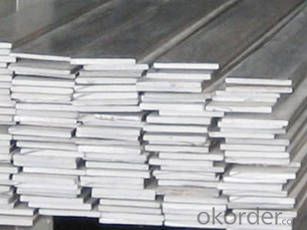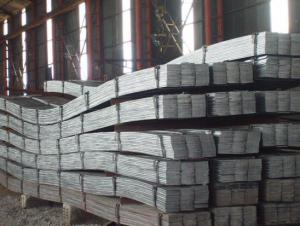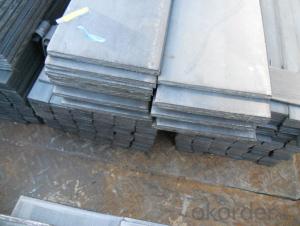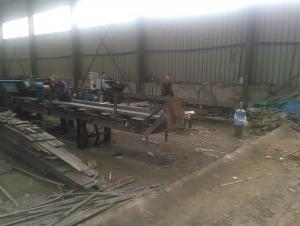Galvanized Steel Flat Bar
- Loading Port:
- China Main Port
- Payment Terms:
- TT or LC
- Min Order Qty:
- -
- Supply Capability:
- 10000 m.t./month
OKorder Service Pledge
OKorder Financial Service
You Might Also Like
Specification of Carbon Steel Flat Bar
Commodity: Carbon Steel Flat Bar
Standard: GB, JIS, ASTM,
Material: Q235, SS400 or Equivalent
Origin place: China
Thickness: 3mm-30mm
Width:20mm-200mm
Length: Max 12m
Certification: SGS/BV
Chemical composition of Q235
Alloy No | Grade | Element(%) | ||||
C | Mn | S | P | Si | ||
Q235 | B | 0.12—0.20 | 0.3—0.7 | ≤0.045 | ≤0.045 | ≤0.3 |
Physical properties of Q235
Alloy No | Grade | Yielding strength point(Mpa) | Tensile strength (Mpa) | Elongation after fracture(%) | ||||||
Thickness (mm) | Thickness (mm) | |||||||||
≤16 | >16--40 | >40--60 | >60--100 | ≤16 | >16--40 | >40--60 | >60--100 | |||
≥ | ≥ | |||||||||
Q235 | B | 235 | 225 | 215 | 205 | 375--500 | 26 | 25 | 24 | 23 |
Usage/Applications of Carbon Steel Flat Bar
Widely used for construction;
Machinery manufacturing;
Iron tower steel structure;
Shipbuilding; Steel grating;
Staircase;
Bridge;
Viaduct;
Railway spare parts;
Boilers making etc.
Packaging & Delivery of Carbon Steel Flat Bar
Packaging Details: The Steel Flat Bars are packed in bundles and loaded in 20 feet/40 feet container, or shipped by bulk cargo ,also we can do as customer's requirements.
Delivery Details:30~45 days upon the receipt of buyer payment by T.T. or L/C.
Production Flow of Carbon Steel Flat Bar
The Carbon Steel Flat Bar is made through three processes:
1.Feeding the material: Feeding the row material (the steel plate) to Slitting Line.
2.Slitting:The steel plate would be slitted into expected width by lengthways cutter.
3. Leveled and cutting: The plat bar would be ground into level by the grinder and then cut into required length.
FAQ:
Q1: Why buy Materials & Equipment from OKorder.com?
A1: All products offered byOKorder.com are carefully selected from China's most reliable manufacturing enterprises. Through its ISO certifications, OKorder.com adheres to the highest standards and a commitment to supply chain safety and customer satisfaction.
Q2: How do we guarantee the quality of our products?
A2: We have established an advanced quality management system which conducts strict quality tests at every step, from raw materials to the final product. At the same time, we provide extensive follow-up service assurances as required.
Q3: What makes stainless steel stainless?
A3: Stainless steel must contain at least 10.5 % chromium. It is this element that reacts with the oxygen in the air to form a complex chrome-oxide surface layer that is invisible but strong enough to prevent further oxygen from "staining" (rusting) the surface. Higher levels of chromium and the addition of other alloying elements such as nickel and molybdenum enhance this surface layer and improve the corrosion resistance of the stainless material.


- Q: What are the different surface finishes available for steel flat bars?
- There are several different surface finishes available for steel flat bars, each offering unique properties and aesthetic appeal. 1. Hot rolled finish: This is the most common surface finish for steel flat bars. It is achieved by heating the steel above its recrystallization temperature and then rolling it to form the desired shape. The hot rolled finish has a rough and scaled texture, making it suitable for applications where appearance is not a primary concern. 2. Cold drawn finish: In this process, the steel flat bar is pulled through a die to reduce its thickness and improve its surface finish. Cold drawn bars have a smooth and polished surface, making them ideal for applications where a clean and sleek appearance is desired. 3. Bright finish: This surface finish is achieved by further polishing the cold drawn bars to give them a high-gloss shine. Bright finish steel flat bars are often used in decorative applications, such as handrails, furniture, and architectural elements, where a reflective and aesthetically pleasing surface is desired. 4. Galvanized finish: Galvanizing is a process in which a layer of zinc is applied to the steel flat bar to protect it from corrosion. The galvanized finish provides excellent durability and resistance to rust, making it suitable for outdoor applications or environments with high moisture content. 5. Coated finishes: Steel flat bars can also be coated with various materials to enhance their appearance or provide additional protection. Common coatings include powder coating, which provides a durable and decorative finish, and epoxy coating, which offers increased resistance to chemicals and abrasion. Ultimately, the choice of surface finish for steel flat bars depends on the specific requirements of the application, including factors such as aesthetics, corrosion resistance, and durability.
- Q: Are steel flat bars available with pre-drilled holes?
- Yes, steel flat bars are available with pre-drilled holes. These pre-drilled holes are commonly used to facilitate easy installation and provide a secure attachment point for various applications. Pre-drilled holes can be found in different sizes and patterns, depending on the specific requirements of the project. The availability of pre-drilled holes on steel flat bars offers convenience and time-saving benefits for users, as it eliminates the need for additional drilling or machining. Whether it is for construction, furniture assembly, or industrial applications, steel flat bars with pre-drilled holes are readily available and widely used in various industries.
- Q: How do steel flat bars contribute to the fire resistance of structures?
- Steel flat bars contribute to the fire resistance of structures by providing structural support and stability. Due to their high melting point and excellent strength, steel flat bars can withstand extreme temperatures, preventing the collapse of the building during a fire. Additionally, they help to distribute the heat evenly, reducing the risk of localized hotspots and structural failure.
- Q: Can steel flat bars be drilled or tapped easily?
- Yes, steel flat bars can be drilled or tapped easily. Steel is a versatile material that can be machined using various tools and techniques. Drilling holes in steel flat bars can be done using a drill press or handheld drill with the appropriate drill bit. Similarly, tapping threads into steel flat bars can be achieved using a tap and die set. However, the ease of drilling or tapping may vary depending on the thickness and hardness of the steel. Thicker and harder steel bars may require more power and specialized tools for drilling or tapping. Additionally, using cutting fluids or lubricants can improve the ease and efficiency of the drilling or tapping process.
- Q: What are the load capacities of steel flat bars?
- The load capacities of steel flat bars vary depending on their dimensions and the specific grade of steel used. However, steel flat bars are known for their high strength and load-bearing capacity, making them suitable for various applications such as construction, manufacturing, and structural support. It is important to consult engineering specifications and calculations to determine the precise load capacities for a specific steel flat bar.
- Q: What is the standard tolerance for steel flat bars?
- The standard tolerance for steel flat bars can vary depending on the specific industry standards and requirements. However, in general, the standard tolerance for steel flat bars is typically expressed in terms of its thickness, width, and length dimensions. For the thickness dimension, the standard tolerance can range from +/- 0.005 inches to +/- 0.010 inches, depending on the manufacturing process and the specific grade of steel being used. This ensures that the thickness of the flat bar is within an acceptable range and meets the required specifications. Similarly, for the width dimension, the standard tolerance can range from +/- 0.010 inches to +/- 0.020 inches. This accounts for any slight variations in the width of the flat bar, ensuring that it remains within the acceptable range for its intended use. Lastly, the standard tolerance for the length dimension of steel flat bars can vary between +/- 0.125 inches to +/- 0.250 inches. This allows for minor variations in the length of the flat bar, ensuring that it meets the required specifications without compromising its functionality. It is important to note that these are general guidelines, and the specific tolerance requirements may vary depending on the application and industry standards. It is always recommended to consult the appropriate standards or specifications for the specific steel flat bar being used to ensure compliance and accuracy.
- Q: Can steel flat bars be used in architectural applications?
- Certainly, architectural applications do make use of steel flat bars. These bars possess versatility and durability, rendering them appropriate for a range of architectural purposes. They find utility in constructing structural components like beams, columns, and braces, bestowing stability and fortitude upon buildings. Furthermore, steel flat bars can confer an ornamental touch, serving as handrails, balustrades, and cladding, infusing architectural designs with a contemporary and polished appearance. With their exceptional tensile strength and resistance to corrosion, architects can rely on steel flat bars as a trustworthy option that harmonizes functionality and aesthetics in their projects.
- Q: How do steel flat bars compare to cast iron flat bars?
- Steel flat bars and cast iron flat bars differ significantly in their composition, strength, and applications. Regarding composition, steel is primarily an alloy of iron with carbon as the main additive, alongside other elements like manganese, chromium, and nickel, depending on the desired properties. Conversely, cast iron also consists mainly of iron but contains a higher carbon content and silicon. In terms of strength, steel flat bars generally surpass cast iron flat bars in durability. The inclusion of specific alloys during the manufacturing process enhances the strength and hardness of steel. Consequently, steel flat bars can withstand higher loads, making them suitable for applications that necessitate structural support or heavy-duty use. While cast iron retains strength, it is more brittle and prone to breaking under excessive stress. Regarding applications, steel flat bars find extensive usage in construction, manufacturing, and general engineering applications. Their high strength and versatility make them ideal for fabricating machinery, supports, frames, and structures. On the other hand, cast iron flat bars are commonly employed in applications that require resistance to wear, heat, or corrosion, such as machine bases, engine blocks, cookware, and architectural elements like columns and decorative pieces. Considering machinability, steel flat bars are generally more manageable to work with compared to cast iron flat bars. Steel possesses a lower melting point, rendering it more malleable and easier to shape or weld. In contrast, cast iron has a higher melting point and proves more challenging to manipulate. Its brittleness can lead to cracking or fracturing if mishandled during machining processes. Concerning cost, steel flat bars often prove more cost-effective than cast iron flat bars. The manufacturing process for steel is more efficient and less expensive, resulting in a lower cost per unit. Conversely, cast iron necessitates a more intricate manufacturing process, encompassing casting and annealing, which increases its expense. In conclusion, steel flat bars offer superior strength, versatility, and machinability, making them more suitable for applications requiring structural support or heavy-duty use. Cast iron flat bars excel in applications demanding resistance to wear, heat, or corrosion. Ultimately, the choice between the two hinges on the specific requirements of the application, budgetary constraints, and desired properties.
- Q: What are the standard packaging options for steel flat bars?
- The standard packaging options for steel flat bars typically include bundling them with steel straps or wrapping them in protective material such as plastic or paper, to ensure safe transportation and prevent damage or corrosion.
- Q: Can steel flat bars be used for manufacturing furniture?
- Yes, steel flat bars can be used for manufacturing furniture. They are commonly used as structural components for creating sturdy and durable furniture pieces. Steel flat bars offer strength, stability, and versatility, making them suitable for various furniture designs and styles.
Send your message to us
Galvanized Steel Flat Bar
- Loading Port:
- China Main Port
- Payment Terms:
- TT or LC
- Min Order Qty:
- -
- Supply Capability:
- 10000 m.t./month
OKorder Service Pledge
OKorder Financial Service
Similar products
Hot products
Hot Searches
Related keywords

























